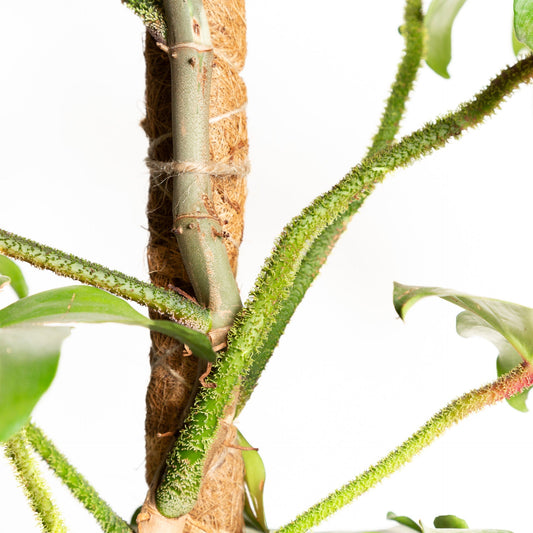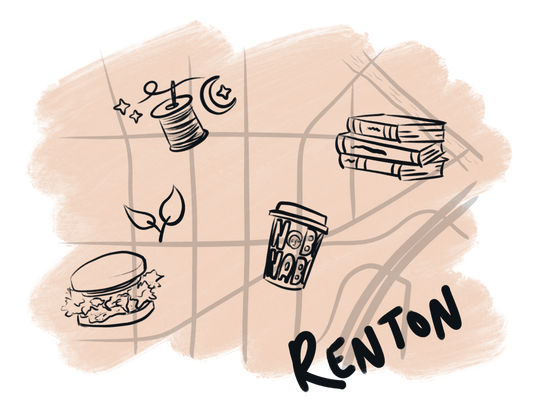The soil that a plant is planted in the most crucial factor in determining the success of that plant, and usually if something is going wrong with the plant it's because something is going wrong with the soil. Arming yourself with knowledge about soil will go a long way towards helping you keep your plants healthy and happy!
First, the science.
Many people don't know that soil (or pedolith if you wanna impress your friends) is actually a living system of organisms. It's an entire ecosystem in its own right.
When you plant something into soil, you are introducing many thousands of tiny living organisms to the roots of your plants. Those organisms interacting with the roots is the process through which the plant absorbs the nutrients it needs. The plant sends chemical signals down into its roots indicating which nutrients the plant needs, and the bacteria in the soil react to those signals and process the nutrients in the soil into a form that the roots can absorb. It's like a whole kitchen of chefs working around the clock to make sure that your plant has the nutrients it needs!
This is actually the reason that we always use bacterial inoculant instead of other fertilizers! Bacterial inoculant replaces the bacteria in the soil which feed your plant exactly what your plant is asking for, whereas other fertilizers offer your plant a single meal at a time that isn't as customized to that plant's needs and often requires a lot more effort to figure out, not to mention the risk of chemical burns.
In nature, all soil is undergoing a constant evolution of many processes that keep the microorganism populations in the soil healthy. Trees die, fall over, and are decomposed; porous materials in the soil absorb gases from the atmosphere and store them to be used by bacteria or any other organisms; earthquakes and landslides shake up the nutrient layers and redistribute material to new areas; water inundates the entire soil layer and is filtered and stored for an extremely long time, frequently only ever coming back to the surface via the evaporation of water from plant leaves. It's an incredibly complex and interconnected system.
However, in the environment of our homes, it's difficult or impossible to replicate these ongoing natural processes that keep the soil invigorated and lively. That means it's up to us to tend to our soils and make sure that they continue to live.
Healthy soil
When you walk out into the forest, it's easy to get a sense for how living soil should look and feel. It's damp, it's loamy, it's got a particular consistency that isn't too crumbly or too sticky. It might vary a little depending on things like elevation or the presence of a body of water, but by and large it stays relatively consistent throughout the area.
Your soil doesn't have to exactly resemble the soil found where you live, but it gives you a pretty good idea of what healthy looks like.
Chemical vs. organic soil
Many plant parents mistakenly purchase chemical potting soil instead of organic. Chemical soil has an amount of nutrients in it that does not replenish, and after typically about a year will run out of food to provide the plant with. This kind of soil cannot be replenished with bacterial inoculant. If you apply bacterial inoculant to this kind of soil, you'll soon notice a layer of what looks like white dust on the top of the soil - that's the bacteria from the inoculant, which was killed by the chemicals in the soil.
Organic soil is leaps and bounds healthier for your plants because it more perfectly emulates the conditions of the outdoors, and you can put literally any plant that wants soil into organic soil. Even cacti - just let the soil dry out before you water it! And, of course, it can be repopulated with bacterial inoculant and kept for years and years.
Unhealthy soil
Temperature fluctuations that heat or cool soil too much will kill the microorganisms inside and hurt the roots of your plant (plants hate cold feet, and no living being likes being cooked). Stick your finger into the soil and gauge its temperature - if it feels like it's super cold or weirdly warm, it's probably a good idea to move your plant to a different area of your home. Ideal temperatures for houseplants are typically between 60 and 85 degrees Fahrenheit. Windowsills are notorious for making soil too cold and vents can heat or dry out plants and their soil, so watch out for those in particular.
It's a common misconception that adding things like banana peels or other rotting things to soil will increase the nutrients in the soil. It's true that certain nutrients will be added, but those nutrients are not in a form that the plant can use. Potassium, for example, is not usable by plants in every way that it occurs, just the same as people can't eat iron or carbon even though we need those things in our diet. Composting is a great idea for the environment, but the resulting nutrients need much more refining before a plant can use them, a process which takes time and effort and basically results in bacterial inoculant anyway. Save yourself the smell!
The two most common problems plant parents face when it comes to the success of their plants are soil that is too dry and soil that is too wet. Both of these problems present soil that feels nothing like the soil in the woods - soil that is too dry has become too crumbly and dusty to hold water any more, and soil that's too wet is more like gross mud than soil and usually has soil gnats. In either case, the microorganisms in the soil are no longer conducive to the health of the plant.
If your soil isn't healthy, hope isn't lost! There are ways you can fix this.
How to re-hydrate dried out soil
Soil that has become completely dry is hydrophobic, which means that water falls right through it without the soil holding any at all. Even if you do water your plant after an extended dry period, it likely isn't retaining enough of that water to make a difference.
- Place the planter, plant and all, in the sink.
- Turn on the faucet and let the stream of water run through the soil.
- Put your fingers into the soil and break it up so that the water running through it begins to stick. Try not to damage the roots as you do so.
- Do this until the soil is completely re-hydrated. Make sure that you're getting into the deepest parts of the soil! Don't leave any hydrophobic spots in any part of the soil. If you can't reach the lowest parts of the soil from the surface, allow the planter to sit in shallow water for 10 or 15 minutes - the soil should suck up water from the drainage holes in the bottom.
- Your soil is now re-hydrated, but it lacks living organisms (because they all died when the soil dried out). Apply bacterial inoculant ASAP.
When it comes to plants like snake plants or cacti, which like to be in soil that dries all the way out between waterings, it's still a good idea to bring that soil back to life when you do water them. Every plant needs food, after all, and living bacteria in the soil is what will feed them.
It's a common practice to water that type of plant by simply allowing them to soak in water from the bottom up for 15 minutes, applying inoculant, and calling it a day. If you choose this method, remember that the dried out soil is hydrophobic and you need to rely on water pressure to get the water up into the drainage holes, so make sure that the water level the plant is sitting in is high enough to push water up into the soil. Stick your finger deep into the soil after it's done soaking to make sure that the moisture level is adequate.
How to repair overwatered soil
Soil that has been holding too much water for too long is going to collect unwanted fungi, both of which are hazards to your houseplant on top of the stress of too much water absorption. It's frequently easier and more effective to replace soil that has been overwatered with fresh organic soil, but all knowledge is good knowledge.
- If your plant is a succulent, cacti, or any plant which is sensitive to overwatering, remove it from the soil before beginning and set it aside to dry.
- Remove the soil from the container and dry the excess water from it. This can be done by leaving it out to dry, soaking out the water with paper towels or some similar medium, with a hair dryer, etc. The soil should not be dried all the way out, just back down to a more normal level.
- Clean the planter with soap and hot water. (This step should be performed even if you opt to replace the soil entirely instead of dehydrating it.)
- Re-pot your plant and quarantine it away from any other houseplants.
- Thoroughly treat your plant and the soil with pest and fungal treatment spray.
- Once the treatment is complete, apply bacterial inoculant to give your plant the boost it needs to recover.
- Applying neem oil to the plant is an optional but wise step you can take to further quarantine your plant from infection after treatment.
Soil that is too wet is avoided by making sure that your planter has a drainage hole in the bottom and by breaking up the soil periodically to allow for better water flow. If your soil gets too dense and compacted, it will block water flow and also make it harder for your plant's roots to penetrate deeper to the areas they want to dig to.
Congratulations!
You're a soil expert now!
If you have any further questions or comments, please leave us a comment on this article or reach out to us. You can always text or call us at (206) 789-0710 or message us on any of our social media pages.




Comments (2)
WmrapURY
PSIyblHQZaex